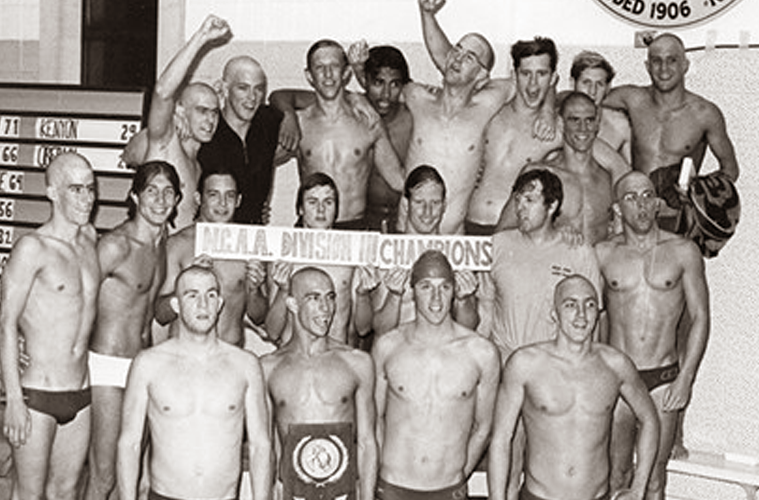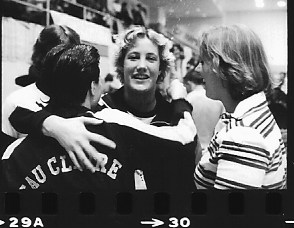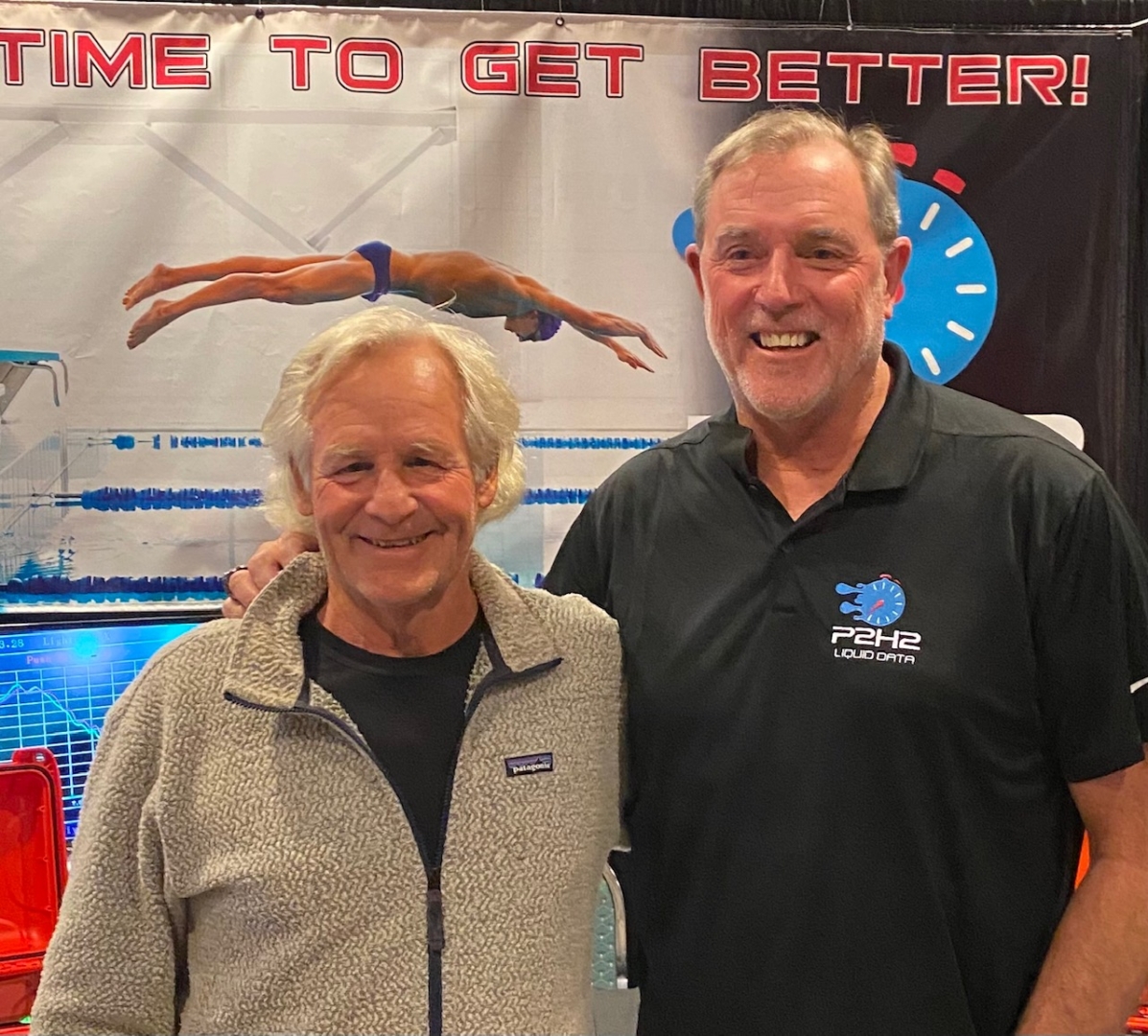Swimming and Diving Team’s Legacy Lives On

For 30 years they made a splash.
As national champions, record-setters, and outstanding competitors, members of Chico State’s decorated swimming and diving team set a lasting impression during its three-decade run—and they continue to make headlines today.
As the College Swimming Coaches Association of America (CSCAA) celebrates its centennial in 2022, Wildcats were named several of the top coaches, swimmers, divers, and teams of the last 100 years.
The recognition comes as no surprise to the more than 400 men and 300 women who plunged into the University Pool from 1961–91.
“I loved watching our athletes be successful, learning, being motivated. They were very competitive and they didn’t like to lose,” said former swim team member and longtime coach Clark Yeager (’71, ’80). “In the pool, they gave it everything they had.”
In 1910, Chico Normal School had its own indoor swimming tank, housed in the rotunda known as the Bath and Amusement Center near today’s Colusa Hall. The first outdoor natatorium was built in 1917, but it wasn’t until Acker and Shurmer Gymnasiums opened in 1960 with a swimming pool and diving tank that the official Wildcat swimming team formed.
Within three years, the men’s program competed in its first conference championship. The next year, it debuted at the NCAAs, saw its first All-Americans, and witnessed William Courter (’66) become its first NCAA Champion, tying the national record in the 100-meter breaststroke. The ensuing decades were filled with medals, trophies, and bragging rights—including hosting the program’s first championships and earning Chico State’s NCAA Swimmer of the Year (Tom Harvill, ’85) and Diving Champion of the Year (Jeff Kunselman, ’96).
The women’s program made an impression of its own. In 1980, the Wildcats placed third at the Association for Intercollegiate Athletics for Women DIII national championships. With 15 swimmers and divers earning All-American recognition, Martha Stanton (’82) led the team by placing second in the 200-yard freestyle and then held the school record in the 100-yard and 200-yard freestyle events for a decade. Diver Karla Helder (’82), now a coach at West Virginia University, won the 3-meter event and placed second in the 1-meter in 1981, and in 1990, Laura Tillie (’93) was the national champion in the 1-meter and placed third in 3-meter diving events at the NCAA Division II National Swimming and Diving Championships.

The 1988 relay team of Diana Brewster (’88), Carolyn Heater (’88), Kristin (Kehle) Nelson (’88), and Trisha Allen (’88) is also legendary, having broken the Chico State team and conference record in the 800-yard freestyle relay, and then shattered their own record during the prelims and again in the finals at the national championships, earning All-America recognition.
“When the program was cut in 1991, we had more All-American swimmers and divers than all the women’s teams put together,” said Debra Roth (’74), who swam as an athlete her four years and then coached for 15 more.
Ernie Maglischo and Yeager—both of whom have been named among the CSCAA’s 100 Greatest Coaches—led the men’s team through the majority of their record-setting years and 19 trips to the NCAA championships. The recognition comes as no surprise to the former players.
“Ernie Maglischo is one of the finest coaches in the country,” said Don Tayenaka, who swam from 1973–74. “He was a scientist first and brought that to swimming in technique and training. It was calculated out to get the best performance out of each of us.”
Even though Yeager was the men’s coach, he played an integral part in the lives of both men and women student-athletes, Nelson said.
“One season I had to train with the men’s team as the women’s practices conflicted with my nursing school obligations,” she recalled. “Clark represented values of integrity, working hard, overcoming obstacles, and many others which have stayed with me throughout my life.”

Maglischo coached from 1966–76, leading the team to four NCAA Championship appearances and seven Far Western Conference titles. He coached 19 individual NCAA champions and 80 All-Americans. His successor, Yeager, led until the program’s end, netting another 15 NCAA top-eight finishes with 19 more individual NCAA Champions, 201 All Americans, and 13 conference championships.
The CSCAA also honors Wildcat Pete Hovland (’77) as a legacy coach. Hovland, named the 1976 Men’s National Swimmer of the Year and the most decorated swimmer in Wildcat history, is a five-time NCAA individual champion and member of Chico State’s four straight NCAA Championship teams from 1973–76.
One of their fondest memories was an annual dual meet with rival Oakland University—conducted over the phone. It always managed to bring in a surprising crowd with great excitement, Yeager notes. Another unconventional meet Chico State helped host was a D2 “computerized” meet in 1981 that provided results between more than 50 schools.
The stands were always full at their meets, Yeager said, as they drew in fans from the campus and community. The camaraderie and athletic success were major draws that enticed students from across the state to the program. Many passed up scholarships or the chance to compete at DI universities to swim and dive for Chico State.
“It drew people for the right reasons,” he said. “They came because they saw what we were doing and they liked the tradition.”
Sadly, in 1991, budget cuts put an end to the men’s and women’s programs. Many student-athletes continued to compete at the national level as members of various US Teams; became coaches at other universities where they led generations of swimmers and divers to their own successes; and launched international programs. To this day, many compete in master’s events, and the camaraderie they shared in the water and from the deck is regularly reignited through meetups to swim competitively at Lake Tahoe or go on vacations. The annual fly fishing trips Tayenaka and his former competitors take part in have become so popular, their children now also attend.
“I have some the fondest memories with the swim team, from morning practices a 6 a.m. and then coming back after classes to 3 p.m. practice every day,” Tayenaka said. “Swimming has some of the most dedicated individuals in sports. The friends I made from the swim team have lasted a lifetime. I’m now 70 years old and we still get together with each other.”
They often find themselves reminiscing about their time toweling off on the Chico State pool deck, the feel of their palms slicing through water, and the thrill of their victories—both personal and their teammates’.
“We always thought of ourselves as family,” Roth said. “It was magical. You watched every yard that they swam. You knew their deepest, heartfelt goals, and you saw them accomplish them. Hard work pays off.”
For Nelson, one player actually became family, as she met her future husband during their years on the swim team. The student-athletes were not just a social group, she said, but a support network that guided all of them through college and their years to come.
“I loved watching our players’ relationships grow with each other, too—the bonding, the caring, and compassion,” Roth said. “If I could do it again, I would.”


